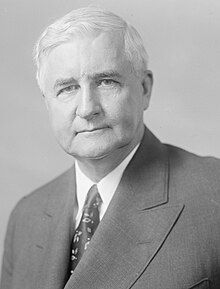Jesse Jones | |
|---|---|
 | |
| 9th United States Secretary of Commerce | |
| In office September 19, 1940 – March 1, 1945 | |
| President | Franklin D. Roosevelt |
| Preceded by | Harry Hopkins |
| Succeeded by | Henry A. Wallace |
| Personal details | |
| Born | Jesse Holman Jones April 5, 1874 Robertson County, Tennessee, U.S. |
| Died | June 1, 1956 (aged 82) Houston, Texas, U.S. |
| Political party | Democratic |
| Spouse |
Mary Gibbs (m. 1920) |
Jesse Holman Jones (April 5, 1874 – June 1, 1956) was an American Democratic politician and entrepreneur from Houston, Texas. Jones managed a Tennessee tobacco factory at age fourteen, and at nineteen, he was put in charge of his uncle's lumberyards. Five years later, after his uncle, M. T. Jones, died, Jones moved to Houston to manage his uncle's estate and opened a lumberyard company, which grew quickly. During this period, Jesse opened his own business, the South Texas Lumber Company. He also began to expand into real estate, commercial building, and banking. His commercial building activities in Houston included mid-rise and skyscraper office buildings, hotels and apartments, and movie theaters. He constructed the Foster Building, home to the Houston Chronicle, in exchange for a fifty percent share in the newspaper, of which he acquired control in 1926.
Jones's participation in civic life and politics began with the Port of Houston and the Houston Ship Channel. He led a group of local bankers in buying public finance bonds and was later appointed to serve as the Chair of the Houston Harbor Board. He led a local fundraising effort on behalf of the American Red Cross in support of servicemen in World War I. President Wilson tapped Jones to head a division of American Red Cross, a duty he fulfilled between 1917 and 1919. In 1928, he initiated and organized Houston's bid for the 1928 Democratic National Convention.
Jones most important role was in the Reconstruction Finance Corporation (RFC) (1932–1939), a federal agency originally created in the Herbert Hoover administration which played a major role in combating the Great Depression and financing industrial expansion during World War II. After Hoover first appointed Jones to the board, President Franklin D. Roosevelt expanded the powers of the RFC and promoted Jones to the chairmanship in 1933. Jones was in charge of spending US$50 billion, especially in financing railways and building munitions factories.[1] He served as the United States secretary of commerce from 1940 to 1945, a post he held concurrently with his chairmanship of the RFC. With the combined authority of these various federal posts, Jones was arguably the second most powerful person in the nation, which is confirmed by Roosevelt's nickname for him, "Jesus Jones".
After leaving Washington, Jesse and Mary Jones focused on philanthropy, working through the Houston Endowment, a non-profit corporation they founded in 1937. Though most of this giving was focused on Texas, some of it flowed to Tennessee and Massachusetts. Much of their philanthropy concentrated on education, including large gifts for a business school at Texas Southern University and another to establish Jones College at Rice University. However, they also made substantial donations to hospitals and for the arts. Many buildings in Houston are named for Jesse Jones, including a music venue in downtown Houston known as Jones Hall.
- ^ Jesse H. Jones & Edward Angly, Fifty Billion Dollars: My Thirteen Years with the RFC (1932–1945) (1951).